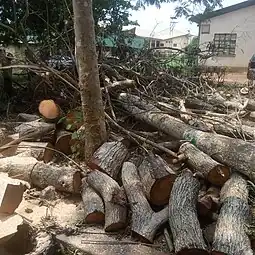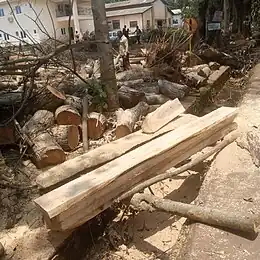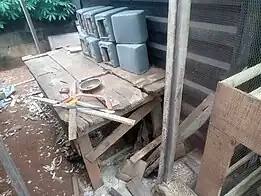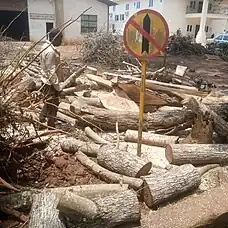Wood industry in Nigeria
The Nigerian wood industry comprises ten prominent sectors, including sawmills, particleboard mills, plywood mills, furniture manufacturing, flush doors production, match industry, wood preservation, toothpick manufacturing, confectionery stick and medical spoon production, as well as pulp and paper mills.[1] Throughout history, wood products have consistently held a substantial role in fulfilling fundamental human requirements for energy, housing, transportation, and a wide spectrum of both long-lasting and perishable commodities.[2] The introduction of wooden floor manufacturing constitutes a recent expansion within the Nigerian Wood Industry.[1]


Amidst the diverse spectrum of wood-based industries in Nigeria, sawmill and furniture manufacturing stand as the most extensive categories in relation to the count of operational mills and the estimated cubic volume of log inputs.[1] The sawmilling and furniture production segments collectively represent more than 70% of Nigeria's Wood Industry in relation to factors such as wood consumption, employment generation, and business volume.[2] The rain forest zone of Nigeria is blessed with ample natural forests because the geographical location of the country in the tropical region naturally promotes the growth of trees and consequently serves as the primary source of abundant wood resources in Nigeria.
History
The history of wood and timber exploitation predates the amalgamation of the Southern and Northern Protectorates in 1900, as well as the establishment of Nigeria as a unified entity and British colony in 1914.[2] Driven by the necessity to meet the timber demand, predominantly for export to European markets and their wood-product manufacturing industries, the level of wood extraction in Nigeria escalated to a juncture where by the late 1800s, the colonial administration initiated the creation of forest reserves on designated lands for this specific objective.[3] This situation persisted into the 20th century, and during the 1970s, the prevailing military administration enacted a prohibition on the export of unprocessed round wood.[3] The status of Nigeria as the foremost wood producer in Africa was underscored by an estimated annual harvest surpassing 100 million cubic meters in 1998.[4]
In the past, Nigeria held a prominent position as a major exporter of timber resources, as evidenced by the export of 781,200 m3 of industrial round wood in 1964, accompanied by a corresponding value of US$36.10 million.[4] In 1966, Nigeria occupied the second position within a group of the seven largest tropical wood producing countries in Africa.[4] Around 1970, the forestry sector contributed approximately 2.5% to Nigeria's Gross Domestic Product (GDP), while exports of wood and wood products constituted roughly 1% of the aggregate foreign exchange earnings.[5] The Wood Industry in Nigeria have been undergoing a process of structural adjustment over the course of the last six decades, aligned with the growth and development unfolding within the economy.[3]
At present Nigeria does not export wood and wood products due to high supply and demand gap being experienced at home.[4] As per the Timber Export Promotion Decree No. 1 of 1998, the export of timber, encompassing both processed and unprocessed forms, as well as rough wood, except for furniture, furniture components, and Gmelina arborea species in any manifestation, is prohibited.[4] The Nigerian government policy on forest industries in Nigeria aims to enhance domestic value by promoting the processing of wood products, resulting in the imposition of export restrictions on logs, rough sawn, and clean sawn wood, while allowing the export of processed wood exclusively.
Production process

Wood processing encompasses operations such as peeling, slicing, sawing, and chemically modifying both hardwoods and softwoods to yield finalized items like boards or veneers, as well as particles or chips employed in the production of paper, particle, or fiber-based commodities, alongside serving as a fuel source.[6] Green wood contains free water in the cell cavities and bound water in the cell walls which has to be removed and then wood is machined to bring it to a specific size and shape for fastening, gluing, or finishing.[6] In various applications such as sawing, hole boring, planning, and shaping, along with the abrasive particles present in sandpaper, a modified form of the sharpened wedge is employed, while wood undergoes grinding into fibers for hardboard, medium-density fiberboard, and paper items, and is sliced and flaked to produce particle-board products, including wafer boards and oriented strand boards.[6]
Wood sourced from the wood industry in Nigeria undergoes processing within a range of wood processing sectors, encompassing furniture manufacturing, sawmill industries, plywood mills industries, pulp and paper facilities, as well as particleboard mills.[7]
- Furniture Manufacturing Industries - Furniture is in various forms such as doors, tables, chairs, decoration, cabinets and shelves, cupboard, beds, among others.[8] These furniture products are present in homes, offices and social infrastructure buildings such as schools, hotels and hospitals.[8] Most importantly, furniture adds style and elegance wherever they are because of their primary functions and designs.[9] Among the spectrum of wood-based industries, wood furniture manufacturing in Nigeria exhibits the most notable recognition and performance levels.[9]
 Wood furniture
Wood furniture - Plywood Milling Industries - Nigeria has predominantly relied on the importation of plywood to fulfill the demand of approximately 965,000 cubic meters necessary within the nation, notably within sectors such as building, construction, and furniture manufacturing.[10] In 2019, Akwa Ibom State government commissioned some ply mill industries in Akwa Ibom like Lim Timber & Plywood Industry.[11]
- Sawmill Industries - Sawmill Industries deal with the conversion of timber into lumber, fashioned into sizes that are both desirable and marketable for applications in constructing houses, barns, fences, bridges, furniture, and musical instruments.[12] In Nigeria, majority of the sawmill industries are located in the wood producing rain forest areas, with a significant concentration evident in the South-Western states, among others. As such, the most significant clustering of sawmills is found within Lagos, Ekiti, Osun, Cross River, Ondo, Oyo, Imo, Edo, Delta, and Ogun States.[13] Collectively, these regions contributed to more than 90% of the sawmilling operations within the nation.[14]
 A Carpentry workshop in Nsukka
A Carpentry workshop in Nsukka - Pulp and Paper Facilities - In the context of Nigeria, a nation experiencing rapid growth, there exists a consistent rise in the demand for paper and its associated products.[15] Within Nigeria, the operational landscape encompasses two pulp and paper mills: the Nigerian Paper Mill Limited (NPM) situated in Jebba, boasting a pulp capacity of 32,000 metric tons per year and a paper production capacity of 70,000 metric tons per year; and the Nigerian Newsprint Manufacturing Company (NNMC) located in Oku Iboku.[16]
- Particleboard Mill Industries - Particle boards are commonly used in various structural scenarios, encompassing functions such as flooring, wall bracing, ceiling paneling, furniture crafting, partitioning, and cladding.[17] The substantial requirement for particleboard in Nigeria has led to a heightened rate of depletion in the limited natural forest resources, prompting concerns regarding the sustained provision of raw materials for the wood-based industries in forthcoming periods.[18] Conventionally, particleboards are produced from chosen particles adhered together with a thermosetting resin.[18]
Paper pulp industry
The paper industry in Nigeria has a long history that dates back to the 1960s and 1970s, when the government established three integrated pulp and paper mills: the Nigerian Paper Mill in Jebba; the Nigeria Newsprint Manufacturing Company, Oku Iboku; and the Iwopin Pulp and Paper Company. These mills were meant to meet the domestic demand for paper products and reduce import dependence.[19]
However, these mills have faced various challenges over the years, such as lack of maintenance, obsolete equipment, inadequate power supply, and scaa rcity of raw materials. As a result, they have either become moribund or are operating at low capacity. According to a report by allAfrica.com, only the Jebba mill still has a shoath of life.[20]
The local production of paper products in Nigeria is estimated at 265,000 metric tons per year, while the domestic demand is estimated at 3 million metric tons per annum.[19] This means that Nigeria relies heavily on importation of paper products to meet its needs, which costs the country about N182 billion annually. Importing paper products also exposes the country to fluctuations in foreign exchange rates and international market prices.[21]
Common wood usage in Nigeria
- Wood for Architectural Purpose - The utilization of these wood species is prevalent among a majority of individuals in the construction of shops, residences, shrines, animal enclosures, and yam storage structures. Currently, the impact of modernization has led to a gradual substitution of traditional architectural wood applications with contemporary building materials such as cement blocks, bricks, aluminum roofing sheets, window glass, and steel rods.[22]
 Restaurant built with wood
Restaurant built with wood - Wood for Musical Instruments - A wide array of musical instruments, encompassing flutes, drums, gongs, bongo drums, okbokolo, ichaka, and others, are crafted from various wood types within the Anaocha, Anambra, Nigeria. These materials range from hardwoods like Iroko to softer varieties such as Akpu (Ceiba pentandra), spanning both historical and contemporary contexts.
 Local drums made of wood
Local drums made of wood - Wood for Carving Religious Figurines - Softwood types such as Akanta (Rauvolfia vomitoria), Ngwu (Alba feminea), Akpu (C. pentandra), and Ube (Dacryodes edulis) are used by most wood carvers in Anaocha for carving figurines and other sacred objects such as Ikenga, Agwu, masquerade masks, and royal stools/drums. This aspect of wood usage in the area is very important because it affirms the people's support for African cosmology and preference in carved objects made with good wood.[22]

- Wood as a Source of Energy Supply - Fuelwood constitutes the main source of fuel for cooking, as more than 76% of Nigerians use fuelwood, leaving only 26% for cooking gas, kerosene, coal, and electricity. Sources of fuelwood include deadwoods, dry branches, twigs, wet/life woods, sawdust from wood, and charcoal extracted from wood. Users of fuelwood in the study area include smiths, palm oil millers, cassava (garri) producers, and bakery industries, among others.[22]

- Wood for Household Furniture - Furniture produced from wood sources in the study area included upholstery, cane chairs, basket, broom, mat, and mortar/pestle. All these constitute household materials used for subsistence living in the study area. Oga tree provides major raw material for cane weaving, and cane crafts are produced in various sizes and shapes to serve different purposes. Its products include cane cupboard, cane bed, cane chair, cane basket, and cane mirror. Baskets, on the contrary, are produced in large quantities, ranging from large to medium and small to extra small sizes serving different purposes.[22]
 An old mortal and pestle made of wood
An old mortal and pestle made of wood - Wood for Casket Production - Across various Igbo-speaking communities and broader regions, wooden materials including bamboo stems and banana leaves were historically employed for interring individuals from varied social strata. In contemporary contexts, wood is meticulously fashioned into a distinct form known as a casket, exclusively designated for the burial of deceased individuals.[22]
- Wood for Fortification - During antiquity, wooden resources such as Ogilisi (Newbouldia laevis) and palm fronds (Elaeis guineensis) served as primary materials for constructing fences and gates surrounding numerous compounds within Igbo communities. This practice persists within the Anaocha Local Government Area, in Nigeria where palm fronds, Ogilisi, and lumber sourced from palm trees continue to be utilized for reinforcing family compounds among those without access to cement blocks. Wood also finds application in delineating boundaries for compounds, agricultural lands, villages, and towns.[22]
Deforestation from illegal logging and fuel wood collection

Deforestation results from the removal of trees without sufficient replacement, which leads to reduction in habitat, biodiversity as well as wood and quality of life. The forest resources in Nigeria are under pressures from urbanization, infrastructure development, residential construction, population growth, nomadic farming and expansion of agricultural crop cultivation About 25% of forest cover was lost from 1991 to 2003 with the remaining forest now standing at about 16 to 17%. Nigeria loss 55.7% of its total primary forest between 2000 and 2005, and the rate of forest change increased by 31.2% to 3.12% per annum. Cooking with fuelwood or charcoal has remained the only alternative to ever increasing cost of fossil fuel in Nigeria.

Illegal logging takes place when timber is harvested, transported, bought or sold in violation of national laws.[23] Sawn timber is imperative in construction activities for residential, recreational and industrial development.[23] In many cases in Nigeria, trees are felled and sawn without any commensurate effort to replant them. In Nigeria as in most third world countries, firewood constitutes the major source of fuel. This is as a result of the rampant, usual and high cost of kerosene and cooking gas leading to a lot of pressure on the forests. It becomes difficult to prevent people from cutting down the forest for firewood when there are no cheap and available alternatives.

With the problems associated with illegal logging several legal responses has been made in other jurisdictions in a bid to addressing the environmental consequences. The legal response in Nigeria often has prohibited the act of illegal logging and the engagement on illegal forest trading. Such concerns are yet to be tackled in Nigeria through effective legal and regulatory frameworks targeted at addressing the issue of illegal logging and its impacts on the environment.[23]
References
- Larinde, Solomon (2020). Readings in Sustainable Tropical Forest Management. Ibadan: Zenith Book house Publishers Ibadan. pp. 277–291.
- Du, Guanben; Xiaojian, Zhou (2023). Wood Industry - Past, Present and Future Outlook. ISBN 978-1-80356-451-7.
- Larinde, S.; Erakhrumen, A.A (2021). "Wood and Wood–Products Movements from and into Nigeria: The Need for Sustainability of Resource Base and Trade" (PDF). Proceedings of the 7th Biennial Conference of the Forests & Forest Products Societ.
- "FOSA Country Report : Nigeria". www.fao.org. Retrieved 2023-08-30.
- Idumah, F.O; Awe, F.; Orumwense, L.A (2022). "Dynamics of Wood Export in Nigeria (1962-2017) An Econometric Analysis" (PDF). Russian Journal of Agricultural and Socio-Economic Sciences (RJOAS). 1 (97): 1994–1999.
- Ohagwua, C.J.; Ugwuishiwu, B.O (2011). "Status of Wood Processing and Storage". Nigerian Journal of Technology. 30 (2): 94–105.
- Mijinyawa, Yahaya; Bello, S.R (2011). "Assessment of Injuries in Small Scale Sawmill Industry of South Western Nigeria". Agricultural Engineering International: The CIGR Journal of Scientific Research and Development: 157 – via ResearchGate.
- Aremo, A.M; Olaniran, A.T (2023). "The Efficiency of Hard Wood Industry in Ondo State, Nigeria" (PDF). Advanced Journal of Social Science. 12 (1): 1–15. doi:10.21467/ajss.12.1.1-15. S2CID 255933026.
- Adedokun., M.O; Soaga, J.A; Oluwalana, S.A; Olawumi, A.T; Mologmhe, I.M.R (2020). "Economic analysis of different wood species in major sawmills in Abeokuta, Ogun State, Nigeria". Journal of Agricultural Science and Environment. 17 (1): 73–82 – via ResearchGate.
- Ibirogba, Femi (2021). "Research council partners UI, FUTA researchers on local plywood". The Guardian.
- Nigeria, Guardian (2021-03-15). "Research council partners UI, FUTA researchers on local plywood". The Guardian Nigeria News - Nigeria and World News. Retrieved 2023-08-31.
- Akinyemi, O; Obadimu, O.O; Sodimu, A.I; Obadimu, O.D. Profitability, Prospect and Constraints, of Sawmill Industry in Kaduna State. https://www.academia.edu/7976076/Profitability_Prospect_and_Constraints_of_Sawmill_Industry_in_Kaduna_State
- Bello, R.S; Mijinyawa, Y. (2010). "Assessment of Injuries in Small Scale Sawmill Industry of South Western Nigeria". Journal of Scientific Research and Development. Manuscript 1558. 12: 1–11.
- Raw Materials Research and Development Council (RMRDC), (2003): Multi-disciplinary committee report of a techno-economic survey on Wood and Wood Products Sector (4th update) December 2003. Pub. Raw Materials Research and Development Council
- Adegbehin, J. O.; Omijeh, J. E. (1989). "Raw Materials for the Pulp and Paper Industry in Nigeria". The Commonwealth Forestry Review. 68 (1 (214)): 35–44. ISSN 0010-3381. JSTOR 42606731.
- "FOSA Country Report : Nigeria". www.fao.org. Retrieved 2023-08-31.
- Hassan, B.B; Awopetu, O.O (2019). "Production and Characterization of Particle Boards from Common Agro Wastes in Nigeria" (PDF). International Journal of Innovative Science and Research Technology. 4 (1): 637–642.
- Abdulkareem, S.A; Adeniyi, A.G (2017). "Production of Particleboards Using polstyrene and Bamboo Wastes". Nigerian Journal of Technology. 36 (3): 788–793.
- Ezeudu, Obiora B.; Agunwamba, Jonah C.; Ezeasor, Ikenna C.; Madu, Christian N. (March 2019). "Sustainable Production and Consumption of Paper and Paper Products in Nigeria: A Review". Resources. 8 (1): 53. doi:10.3390/resources8010053. ISSN 2079-9276.
- Onwuamaeze, Dike (15 February 2022). "Nigeria: Paper Industry - a Sector in Death Throes". This Day.
- "Nigeria misses out on $351bn market as paper mills remain moribund". Businessday.ng. 7 February 2022.
-
 This article incorporates text available under the CC BY 3.0 license. Okonkwo, Emeka E.; Ukaegbu, Maureen O.; Eyisi, Afamefuna P. (2016-04-01). "A Documentation of Some Traditional Aspects of Wood Consumption in Anaocha, Nigeria". SAGE Open. 6 (2): 215824401664941. doi:10.1177/2158244016649417. ISSN 2158-2440.
This article incorporates text available under the CC BY 3.0 license. Okonkwo, Emeka E.; Ukaegbu, Maureen O.; Eyisi, Afamefuna P. (2016-04-01). "A Documentation of Some Traditional Aspects of Wood Consumption in Anaocha, Nigeria". SAGE Open. 6 (2): 215824401664941. doi:10.1177/2158244016649417. ISSN 2158-2440. - Justice, E.C; Chijioke-Agumagu, M.O; Kalio, V.O; Delewa, K.E (2022). "Illegal Logging and Environmental Impacts: The Case Of Nigeria And Lessons From USA And Australia". The Journal of Environmental and Human Right Law. 2 (6): 140–161.